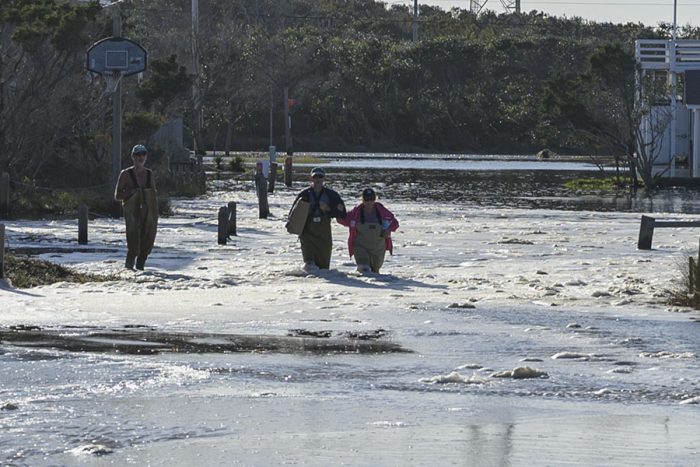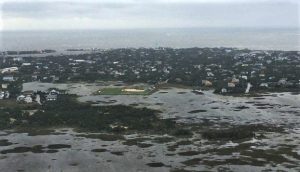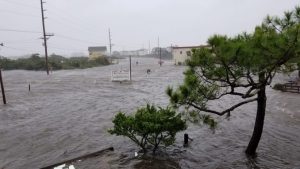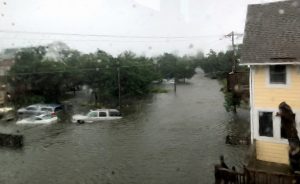
Sponsored | DEEPP
An ongoing research project is tackling a familiar topic in a new and distinct way, and the results have the potential to help communities, and how local, state, and even federal governments and organizations plan for the future.
 The initiative is the DEEPP project, and the years-long enterprise is aimed at crafting a better understanding of the impact of storms, both on a scientific and a personal level.
The initiative is the DEEPP project, and the years-long enterprise is aimed at crafting a better understanding of the impact of storms, both on a scientific and a personal level.
Concentrating on coastal communities, the DEEPP team is currently in the process of working with Hatteras Island residents to paint a clearer picture of how communities face recurring storms, and how they deal with the blows long after a storm is over.
The Dynamics of Extreme Events, People, and Places group, (or simply DEEPP), consists of an interdisciplinary team of scientists interested in the environmental, economic, social, and psychological impacts of storms and floods in coastal Carolina communities. The organization combines survey data with satellite imaging, flood mapping, and storm surge mapping in order to eventually provide community planners and policymakers with information they can use for future disasters.
But it’s the focus on the direct and indirect impact of storms on people that makes this extensive research project distinct, and it’s a large component of the project which requires hundreds of personal interviews with residents who understand these issues all too well.
“If the only data you have is data from property damage, you’re missing a lot of the complexity of how storms affect people, and the duration of those effects,” said Elizabeth Frankenberg, PhD, project leader and Professor of Sociology at UNC-Chapel Hill.
Frankenberg had worked on a similar project in Indonesia after the 2004 tsunami, which focused on both the landscapes and environments affected by the tsunami, as well as the impacts to the people who were in the midst of the disaster.
After Hurricane Florence in 2018 and Hurricane Dorian in 2019, which both devastated sections of the N.C. coastline, Frankenberg and her UNC team saw an opportunity for a similar but deeper study that was close to home.

The group met for six months to hash out the specifics of the project, and to determine what types of data would result in the most comprehensive, accurate, and ultimately useful information. From there, the multi-disciplinary team went to work on the varying aspects of the project – like flood maps and satellite imagery – which included a massive effort to conduct interviews.
“Across four counties, we’re targeting around 1,000 households,” said Frankenberg. “We have already started work in three of the counties, and we’re expanding [the work] in the spring and summer.”
“The interviews are almost entirely face to face,” she added. “The questions can be complex, and it’s much easier to explain why we’re doing this when we’re face to face [with the interviewee.]”
Ocracoke was one of the first launching points for the interview work, and Frankenberg and Nathan Dollar, (DEEPP team member and PhD Candidate in Sociology at UNC-Chapel Hill), estimate that their work in the Ocracoke area, including interviews, is roughly 90% complete.
Now, their sights are set on Hatteras Island, where 100 households have been randomly selected to participate in the in-depth survey. Approximately 80-85% of the households include resident homeowners, and about 15-20% are long-term renters. “Often, renters are excluded from the discussion of the impacts of flooding and hurricanes, so want to get them included in our survey as well,” said Frankenberg.
Non-resident property owners are also included in the survey on a smaller scale, but the research is really focused on the folks who live and work in an impacted coastal area. The DEEPP team has enlisted a local resident, Linda O’Neal, to help coordinate the meetings, and the interviewers include DEEPP team members as well as UNC students and local islanders.
Now going on its second year, the DEEPP project has already uncovered a few trends when it comes to storm recovery.
“One of the things is just the amount of time and effort that has gone into reconstruction is enormous,” said Frankenberg. “People have put a lot of effort into their own rebuilding, but have also spent a lot of time helping others as well. It’s a very interconnected network.”

The survey results are also revealing the extent of disruption to everyday lives after a storm like Dorian or Florence hits a coastal community. While other research projects focus on the dollar amounts of property damage, or the depth of flooding in a specific area, the DEEPP project is taking a deeper dive into areas of storm recovery that can’t be determined by statistics alone.
“We’re [collecting data] on how communities work together, and all the mundane tasks that go into recovery, and how neighbors help neighbors,” said Dollar. “[And] one of the unique aspects of our survey is that we’re asking people how their health is affected. People’s physical and mental health is impacted by storms, and we don’t have good data yet on those impacts, and how long they last.”
Once a report on the findings is complete, the results will be given to local and state organizations and policymakers, but will also be distributed to the individual residents themselves, as well as local groups like the Cape Hatteras United Methodist Men or the Hatteras Island CERT team, who may also benefit from the information.
“We are hoping this can really be useful on multiple levels of government,” said Frankenberg. “A lot of discussions tend to be very property-focused, (and on the dollar amount of property damage), and I’d argue that emergency preparedness plans tend to be property-focused as well. We hope this is a more people-centered approach to storms and recovery.”
The 100 random Hatteras Island residents selected for the DEEPP project have likely received multiple letters, or even an in-person visit by now. If not, an in-person interview is on the horizon, and participants should know that all of their answers are completely confidential, and they can answer as many or as few questions as they would like.
“The strength of our project really relies on the participants,” said Dollar. “We have the representative sample that captures an entire community, but the data is only useful if people respond to the survey.”

“We recognize that people aren’t excited about sitting down and filling out a survey, and with good reason, as people are often skeptical about researchers,” he added. “The Outer Banks are always poked and prodded by academics for various reasons. People come in, take information, and they leave, and nothing comes from it.”
“We really want to have a collaborative relationship with the community… We’re going to share our findings with them, and work with different groups and agencies [going forward.]”
The DEEPP project is also welcoming input from residents who were not directly asked to participate in the survey. Folks who would like to do so, or who have any questions, comments, or suggestions, can contact the DEEPP team via email at DEEPP@unc.edu.
In the meantime, Hatteras Islanders can expect to see DEEPP researchers in their neighborhood in the next few weeks and months, as the team continues their work to create more personal and actionable solutions for a recurring problem – storm recovery – that is likely not going away anytime soon.
DEEPP is a collaborative effort of the Carolina Population Center, the Institute for Marine Sciences, the Institute for the Environment, the Odum Institute, and the Coastal Resilience Center. DEEPP is made possible through a Creativity Hub grant from the University of North Carolina at Chapel Hill and a Growing Convergence Research award (CGR 2021086) from the National Science Foundation.
To learn more about the DEEPP project, visit https://deepp.cpc.unc.edu/.










What a complete waste of time
What a completely odd comment. Disaster research is a waste of time? Would you care to elaborate?
And if it’s such a waste of time, why did you care enough to waste your time?